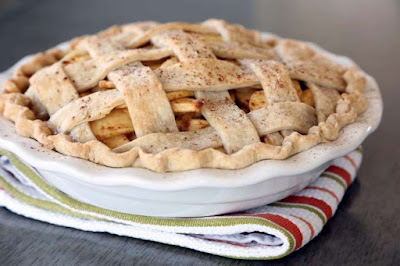I don't know what one has to do with the other and the fourth of July is exactly a month from now as of this writing...but there is no need why you can fix a delicious and irresistable Apple Pie right now...just for the hell of it..
All the amazing apple varieties are finally popping up in farmers markets right now.. and grocery stores, meaning it's officially apple pie season.(It's always Apple Pie season to me!) And you know what everyone loves? Besides the aroma of apples and cinnamon dancing in the air, people love surprise slices of apple pie. Irresistable Apple Pie.
INGREDIENTS:
Crust:
2 cups all-purpose flour, plus more for rolling dough
1 teaspoon salt
3/4 cup shortening (recommended: Crisco)
Ice water
Filling:
6 apples, peeled, cored, and cut into thin slices (recommended: Jonagold, Rome Beauty, or Pink Lady apples)
1/2 cup granulated white sugar, plus more for garnish
1/2 cup dark brown sugar
1 teaspoon cinnamon, plus more for garnish
1/2 cup to 1 cup all-purpose flour (depending on juiciness of apples)
2 tablespoons butter
Special equipment: 9-inch pie pan
DIRECTIONS:
- To make dough: In a medium mixing bowl, combine flour and salt, and cut in the shortening by hand or with a food processor until it's the texture of wet sand, taking care not to overmix. Sprinkle 1 tablespoon of ice water over the mixture and mix just until the dough is moistened. Repeat by adding 6 to 8 tablespoons water (one at a time) until all the dough is just moist. Knead the dough about 10 times until it comes together in a ball. Cut the dough in half and flatten each half into a rough disk. Wrap each disk tightly in plastic wrap, and refrigerate for 1 hour (or up to 3 days).
- Preheat the oven to 375ºF. Remove 1 dough disk from fridge, and discard plastic wrap.
- Sprinkle flour on a clean flat surface (either a cutting board or a clean countertop). Place dough on the floured surface and sprinkle both sides with a generous dusting of flour. Dust the rolling pin with flour as well. Roll out to fit a 9-inch pie plate. To transfer the pastry to the pie plate, wrap it around a rolling pin and ease it into the pie plate. Be careful not to stretch the pastry. Trim it even with the edges of the pie plate. Return to the fridge for at least 20 minutes.
- To make filling: In a large bowl, combine apples and sugars. Stir until sugar thoroughly coats the apples. Then add cinnamon and enough flour to coat the apples.
- Remove pastry-lined pie plate from the fridge and add the apple filling. Make sure the apple slices are laying flat. Cut butter into small pieces and put on top of the filling. Return to the fridge.
- Remove the second dough disk from the fridge and repeat process of flouring each side before rolling it out into a 12-inch circle. Cut dough into 1-inch strips. Remove pie from the fridge. Using the dough strips, form a lattice pattern on the top. Crimp the edges, as desired. Sprinkle a little sugar and cinnamon over the pie.
- Bake for 45 minutes, or until pie is golden brown. Wrap foil around the edges of the pie if it begins to brown too quickly. Serve warm with vanilla ice cream.
Enjoy! Eat Well My friends!




1 comment:
Mmmmm looks good!
Post a Comment